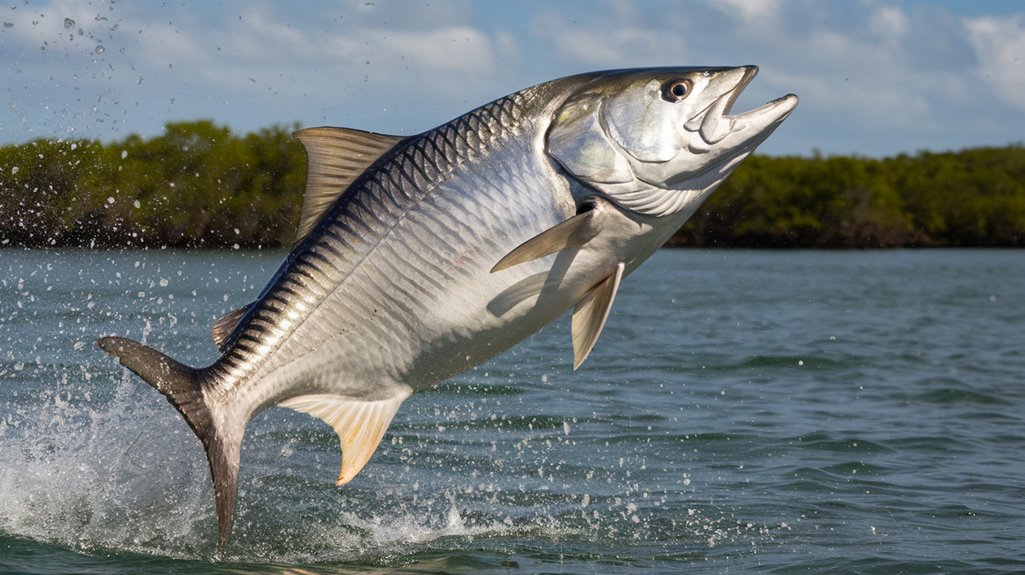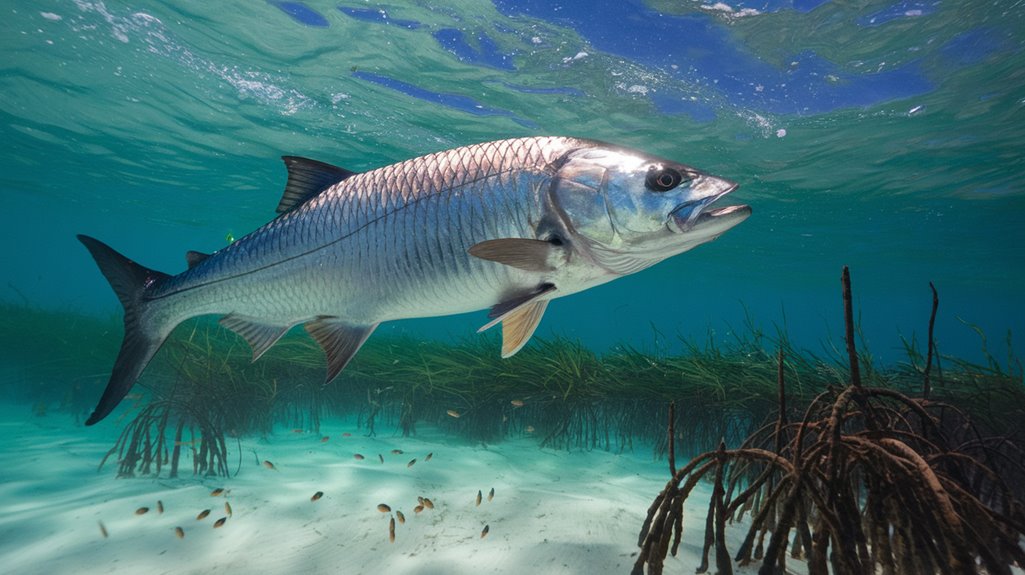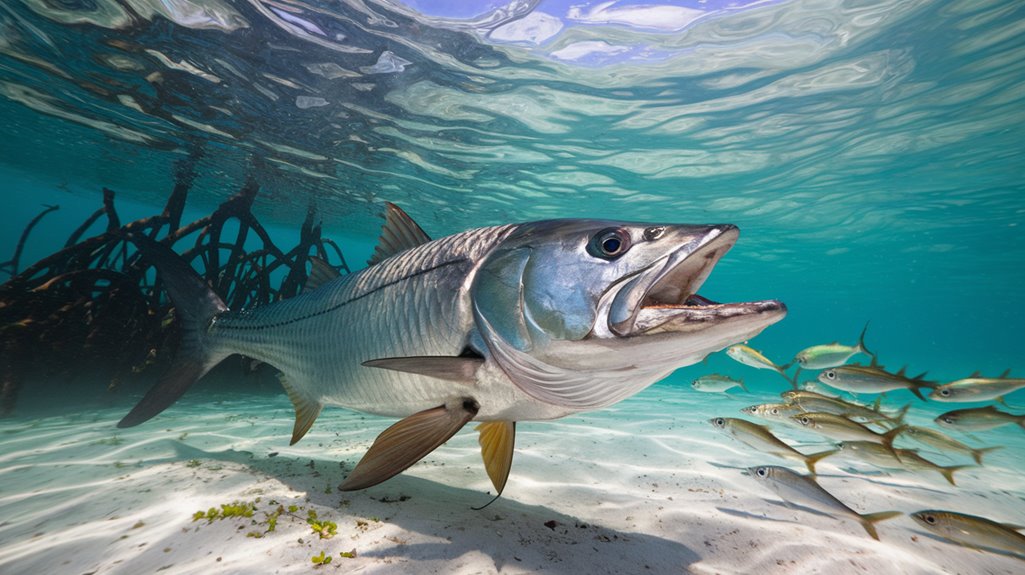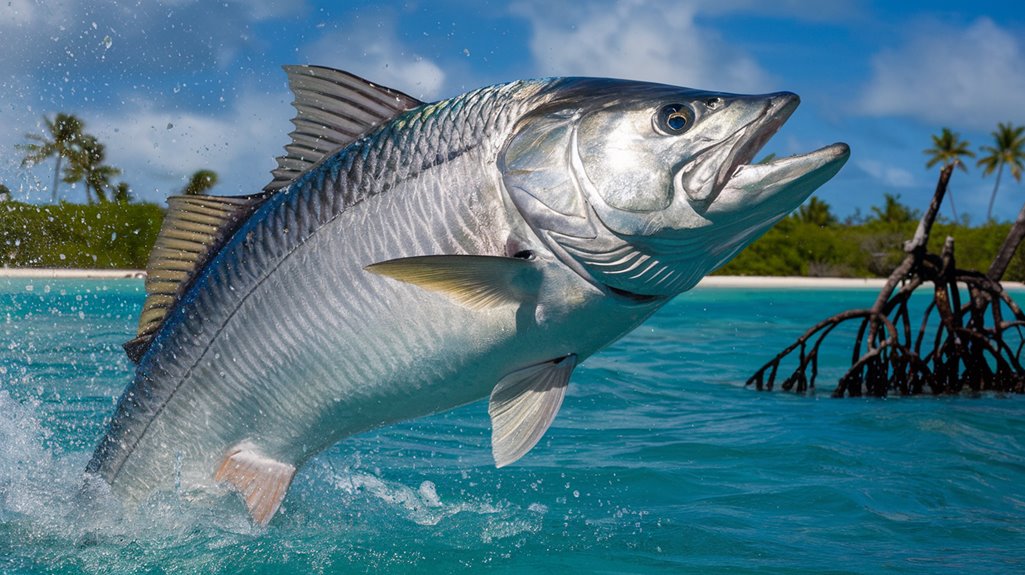You'll discover that Atlantic tarpon distribution follows distinct patterns linked to water temperature and coastal geography. These magnificent fish dominate warm waters from Bermuda's northern reaches to Brazil's southern coast, with concentrated populations in the Gulf of Mexico and Caribbean Sea. While their primary range is well-documented, recent evidence suggests expanding territories and shifting migration routes that warrant closer examination of their habitat preferences.
- Key Takeaways
- Geographic Range of Tarpon Species
- Essential Coastal Habitats
- Temperature and Water Quality Requirements
- Migration Patterns and Movements
- Feeding Grounds and Prey Selection
- Nursery Areas and Spawning Sites
- Human Impact on Tarpon Distribution
- Conservation Status and Population Trends
- Frequently Asked Questions
- Conclusion
Key Takeaways
- Atlantic Tarpon inhabit warm coastal waters spanning from Bermuda to Brazil, with significant populations in the Gulf of Mexico and Caribbean.
- Tarpon thrive in water temperatures between 24-30°C and can tolerate salinity ranges from 5 to 35 ppt.
- Juveniles prefer coastal ponds within dense mangrove forests, while adults utilize diverse marine ecosystems including estuaries and tidal rivers.
- These fish require interconnected coastal ecosystems with good water flow and dissolved oxygen levels above 5 mg/L.
- Tarpon undertake extensive migrations across several hundred kilometers for feeding and breeding, following seasonal environmental cues.
Geographic Range of Tarpon Species

The Atlantic Tarpon's extensive geographic range spans thousands of miles across warm coastal waters, stretching from Bermuda southward to Brazil. You'll find significant Atlantic Tarpon populations throughout the Gulf of Mexico and Caribbean Sea, where they've established essential foraging areas and spawning locations. These fish demonstrate remarkable adaptability across diverse marine ecosystems, regularly moving between estuarine environments, tidal rivers, and coastal lagoons. Their geographic distribution is heavily influenced by water temperature preferences, as they thrive in waters between 24°C and 30°C. When you're studying their habitat preferences, you'll notice they utilize different areas throughout their life stages, often undertaking long-distance migrations exceeding several hundred kilometers to reach ideal feeding and breeding grounds.
Essential Coastal Habitats
Within coastal ecosystems, Atlantic tarpon depend on a complex network of interconnected habitats that support their multi-stage life cycle. You'll find these fish utilizing diverse environments, from estuaries to mangrove-lined tidal creeks, where specific geomorphological features create fundamental fish habitats. Juvenile tarpon particularly thrive in coastal ponds nestled within dense mangrove forests, which provide essential shelter and foraging opportunities. These habitats' environmental conditions, including salinity and dissolved oxygen levels, directly influence tarpon distribution and survival rates. The connectivity between coastal ponds and estuarine systems plays an important role, as it enables juveniles to access nutrient-rich waters necessary for growth. You'll notice that successful tarpon populations rely heavily on these interconnected coastal environments maintaining ideal water quality parameters.
Temperature and Water Quality Requirements

As environmental conditions fluctuate throughout coastal systems, Atlantic tarpon exhibit distinct preferences for specific water quality parameters that influence their distribution and survival. You'll find these fish thriving in estuarine environments where temperature ranges between 20-30°C, with ideal growth at 26°C. They're particularly adaptable to varying salinity levels, successfully inhabiting waters from 5 to 35 ppt.
| Parameter | Ideal Conditions |
|---|---|
| Temperature | 20-30°C (68-86°F) |
| Salinity | 5-35 ppt |
| Dissolved Oxygen | >5 mg/L |
| Habitat Type | Coastal ponds, mangroves |
| Water Flow | Connected to tidal creeks |
Juvenile tarpon show strong preferences for well-oxygenated waters exceeding 5 mg/L dissolved oxygen. They're commonly found in protected nursery habitats, particularly mangrove areas and coastal ponds that provide both shelter and abundant food sources while maintaining these essential water quality parameters.
Migration Patterns and Movements
Driven by spawning behaviors and environmental cues, Atlantic tarpon undertake extensive migrations that span hundreds of kilometers across their range. You'll find distinct migratory patterns on either side of the Mississippi River Delta, where seasonal migrations occur throughout the Gulf of Mexico.
Telemetry studies have revealed that mature tarpon display both wide-ranging seasonal migrations and localized habitat use. You'll observe these fish moving strategically between freshwater and estuarine habitats during their travels. Their population dynamics depend heavily on these movements, with spawning locations correlating to areas where researchers have found larval distribution patterns.
Understanding these complex migratory patterns is vital for conservation efforts, as tarpon's extensive movements cross multiple jurisdictional boundaries, requiring coordinated management approaches to protect their diverse habitat requirements.
Feeding Grounds and Prey Selection

The feeding behavior of Atlantic tarpon directly links their migratory movements to specific habitat preferences. You'll find these fish selecting distinct feeding grounds based on their life stage and seasonal patterns. In coastal ecosystems, juvenile tarpon prefer shallow, brackish waters where they've access to zooplankton and small fish.
| Life Stage | Feeding Ground | Primary Prey |
|---|---|---|
| Juvenile | Brackish waters | Zooplankton |
| Sub-adult | Mangroves | Crustaceans |
| Adult | Deeper estuaries | Mullet, Menhaden |
The distribution of prey species markedly influences where you'll locate Atlantic tarpon throughout the year. They're drawn to productive estuarine environments, particularly areas with mangroves and seagrass beds that support diverse prey populations. During seasonal migrations, they'll shift their feeding grounds to match prey availability, often coordinating spawning activities with peak prey abundance periods.
Nursery Areas and Spawning Sites
You'll find juvenile Atlantic tarpon utilizing intricate networks of mangrove forests as their primary nursery grounds, where dense vegetation and isolated ponds provide essential protection during early development stages. The distribution of these nursery areas isn't random, as specific environmental parameters including salinity levels, temperature ranges, and vegetation structure determine their suitability for young tarpon. Adult tarpon's spawning activities concentrate in offshore coastal waters during warmer months, particularly from late May through mid-September, when conditions are ideal for egg and larval development.
Mangrove Nursery Patterns
While tarpon spawn in offshore waters, their larvae undertake vital migrations to estuarine and coastal environments, where mangrove-fringed ponds serve as primary nursery habitats. You'll find juvenile tarpon thriving in these coastal ponds, where dense mangrove forests create protected environments essential for their development. These nursery habitats exhibit varying salinity levels and dissolved oxygen concentrations, demonstrating the species' adaptability.
Key patterns in mangrove nursery habitats include:
- Geomorphological features and landscape elevation directly influence habitat connectivity
- Tidal creek connections enhance ecosystem health, benefiting juvenile tarpon populations
- Protection of both spawning sites and nursery areas is essential for species survival
The complex relationship between habitat connectivity and ecological benefits underscores the importance of preserving these unique mangrove-dominated nursery environments.
Offshore Spawning Locations
During late spring through early fall, Atlantic tarpon congregate in offshore spawning locations characterized by nutrient-rich waters near river mouths and coastal inlets. You'll find these estuarine and coastal waters serve as critical reproduction zones, where satellite telemetry studies have documented specific spawning grounds throughout the Gulf of Mexico and Caribbean Sea.
The success of tarpon populations depends heavily on the connectivity between spawning sites and juvenile habitats. After spawning, young tarpon migrate to protective environments within tidal creeks and coastal ponds. These nursery areas, featuring dense mangrove forests and seagrass beds, provide essential shelter and food resources for juvenile development. You'll notice this habitat pattern consistently supports the species' early life stages before they shift to deeper offshore waters.
Human Impact on Tarpon Distribution
As coastal development and human activities continue to expand, tarpon populations face mounting pressures that greatly alter their natural distribution patterns. You'll find that habitat degradation directly impacts their spawning grounds and juvenile development areas, while overfishing through recreational fishing practices increases mortality rates. The introduction of pollutants from urban and agricultural runoff compromises water quality, affecting both tarpon and their prey species.
- Construction barriers like dams and levees disrupt migration patterns, preventing access to critical spawning areas
- Conservation efforts struggle due to insufficient data on population dynamics and habitat utilization
- Water quality degradation from industrial and agricultural activities reduces suitable nursery grounds
These anthropogenic impacts require immediate attention through science-based management strategies to preserve tarpon populations and their essential habitats.
Conservation Status and Population Trends
These mounting human pressures have culminated in the IUCN's classification of Atlantic tarpon (Megalops atlanticus) as Vulnerable, reflecting serious concerns about their population stability. You'll find considerable declines in catch rates, with Florida Bay's recreational fisheries showing a 42% decrease since the late 1980s.
| Parameter | Impact | Significance |
|---|---|---|
| Population Trends | 42% decline in CPUE | Critical conservation metric |
| Economic Value | $300M+ annually | High stakeholder importance |
| Research Status | Notable data gaps | Management challenge |
While seasonal migrations considerably influence tarpon distribution, you'll notice that extensive data gaps in population dynamics hinder effective conservation strategies. The species' considerable economic value to recreational fisheries ($300M+ annually) underscores the urgent need for enhanced management approaches to address threats from overfishing, habitat degradation, and bycatch mortality.
Frequently Asked Questions
What Is the Habitat of Tarpon?
You'll find tarpon in warm coastal waters, including estuaries, lagoons, and mangrove swamps. They migrate between shallow, vegetated areas as juveniles and deeper, saline waters as adults.
What Is the Habitat of the Indo Pacific Tarpon?
You'll find Indo-Pacific tarpon inhabiting coastal waters, estuaries, and mangrove systems from the Red Sea to western Pacific. They're adaptable to varying salinities, frequenting coral reefs and seagrass beds.
What Does a Tarpon Fish Look Like?
You'll notice a tarpon's elongated body with large, silvery scales, deeply forked tail, and extended upper jaw. They're massive, reaching 2.4 meters, with a distinctive dark blue-green dorsal coloration.
How Long Has Tarpon Been Around?
You'll find that tarpon have inhabited Earth's waters for over 100 million years, dating back to the Late Cretaceous period, making them one of today's most ancient surviving fish species.
Conclusion
You'll find that Atlantic tarpon distribution patterns correlate directly with specific environmental parameters, particularly water temperature ranges of 24-30°C and the presence of intact mangrove ecosystems. Your understanding of their habitat requirements must account for both juvenile and adult life stages, as they're dependent on diverse coastal environments. Current data suggests you'll need to monitor anthropogenic impacts and climate fluctuations to predict future distribution shifts.

